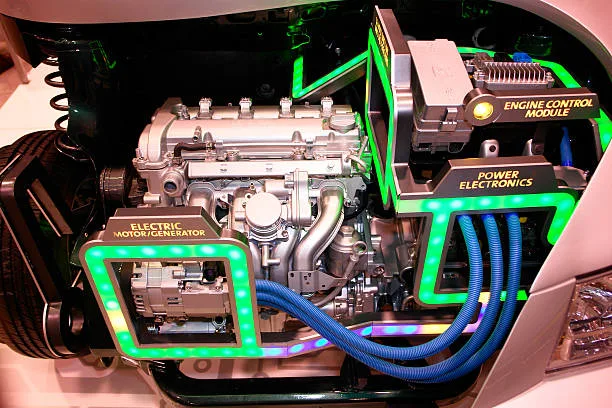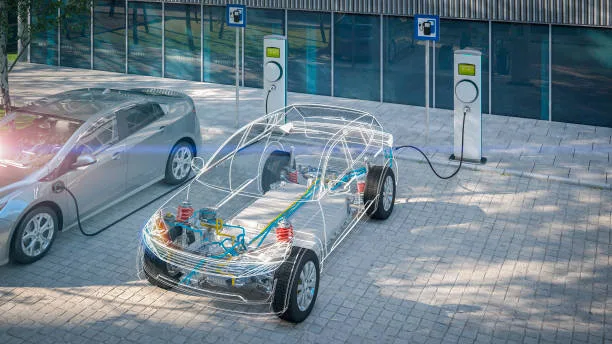Motors in Electric Vehicles | 2023
EV Car Motors
In an electric automobile, in electric vehicles, the battery in the vehicle provides electricity to the stator when the driver presses the accelerator. This causes the rotor to turn, which then releases mechanical energy to turn the gears. The wheels also turn once the gears are in motion. All of this occurs instantly and without the burning of fossil fuels.

Direct current motors can be found in electric vehicles; however, they are merely tiny, micro motors that are utilized for things like electronic windows and windshield wipers rather than for actual driving. An alternating current motor is used to provide traction for electric vehicles.
Asynchronous (also known as induction) and synchronous AC electric motors are the two varieties utilized to generate propulsion for an electric vehicle.
The rotor of an asynchronous or induction motor is propelled into rotation while continuously attempting to “catch up” with the revolving magnetic field produced by the stator. This kind of electric car motor is widely used in automobiles and is recognized for its high power output.
On the other hand, in a synchronous motor, the rotor rotates at the same rate as the magnetic field. This is perfect for driving in cities because it has a lot of torque at low speeds. A synchronous electric car motor can be small and light, which is another benefit.
The Drivetrain

The powertrain is the collective name for the several components that make up an electric car’s electric motor. Along with the gear motor, which controls torque (turning force) and rotational speed, this location also houses the Power Electronic Controller (PEC), which is in charge of the electronics that regulate the motor’s power supply and battery charging.
The many components of an EV motor must be built with true knowledge. “To build a stator, for example, we had to find how to wind 2 kilometers of copper wire into little notches in sheet metal without damaging the insulating ceramic that covers them.”
DC motors are frequently used in electric trains, forklift trucks, and some electric vehicles. It is possible to use AC or DC after using universal motors in specific circumstances. Different motor types have been used in contemporary mass-produced automobiles, including permanent magnet machines in the Nissan Leaf and Chevrolet Bolt and induction motors in Tesla Motors’ vehicles.
Improvements in powertrain efficiency are ongoing.
Output of an electric car

The difference between the provided electricity (input) and the “useful” mechanical energy that powers the motor (output), also known as the energy conversion efficiency, is what determines how much power an electric vehicle can produce. Some of this power may be lost due to heat and friction during travel, which means the motor may not receive the full amount of power from the electric car’s battery.
Energy is wasted during the process of transferring electrical energy to mechanical energy, and charging efficiency varies greatly depending on the type of charger.
The motor volume and current wattage of an electric vehicle determine how much power it can produce. For instance, ZOE produces 100 kW of output with an increased torque of 245 Nm. With a 52 kWh battery, the new ZOE performs particularly well in terms of energy economy, offering a 395 km WLTP range.
Electric motor power

Similar to other machinery, the electric motor power of a car is expressed in kilowatts (kW). Over a large RPM range, electric motors can produce their maximum torque. This means that a car with a 100 kW electric motor performs better than a 100 kW internal combustion engine, which can only produce its maximum torque over a narrow speed range. Similar to other machinery, the electric motor power of a car is expressed in kilowatts (kW). Over a large RPM range, electric motors can produce their maximum torque. As a result, a car with a 100 kW electric motor performs better than a 100 kW internal combustion engine, which can only produce.
FAQ
- What size electric motor does a car require?
Considering that a car needs 6 to 8 HP for every 1000 pounds, a 4000-pound automobile would need 4×6 HP multiplied by 2 for a total of 48 HP to propel it up a 2% incline at 50 MPH. Internal combustion engines have much less torque at low speeds than do electric motors.
2. What type of motor does an EV typically use?
DC motor without brushes (BLDC): There are permanent magnets, and they are employed in hub or belt-drive motors. They are highly efficient, need little maintenance, and have a high initial torque.
3. Why do electric vehicles use BLDC motors?
In comparison to other electric motor constructions, the BLDC motors have the following key advantages: great durability, high efficiency, comparatively low weight, and small dimensions.
4. Which EV motor is the best?
AC induction motors are more advanced and efficient than DC motors. AC motors are also known as asynchronous motors.
An alternating current provides a magnetic field to the rotor, which interacts with the stator to produce torque.
A few of Tesla’s vehicles, for instance, feature AC induction motors.

Follow our Digiknowledge.co.in page for the latest updates about bikes, cars, sports, government policy, and many more.





Can you be more specific about the content of your article? After reading it, I still have some doubts. Hope you can help me.
Of course, I’d be happy to help clarify any doubts you have about the article! Could you please let me know what specific aspects or points you found unclear? That way, I can provide more targeted assistance and address your concerns effectively.
Your point of view caught my eye and was very interesting. Thanks. I have a question for you.
Thank you so much! I’m really glad you appreciate the originality and find value in the content here. It’s always rewarding to know that the effort to bring fresh perspectives is recognized. If there’s a specific topic you’d like to explore or dive deeper into, feel free to share—I’m here to help!